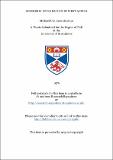Files in this item
Economic integration in West Africa
Item metadata
| dc.contributor.advisor | Robson, Peter | |
| dc.contributor.author | Ezenwinyinya, Michael Uka | |
| dc.coverage.spatial | (xiv, 527) p. | en_US |
| dc.date.accessioned | 2018-07-12T08:25:33Z | |
| dc.date.available | 2018-07-12T08:25:33Z | |
| dc.date.issued | 1976 | |
| dc.identifier.uri | https://hdl.handle.net/10023/15280 | |
| dc.description.abstract | This study offers some empirical insight into the problems and possibilities of economic integration in West Africa with particular reference to Ghana and the Entente Council States (i.e. Ivory Coast, Upper Volta, Niger, Dahomey and Togo). Recent developments in integration analysis have shown that the traditional theory of integration is largely inapplicable to the economies of LDCs. Economic integration in the case of LDCs should be treated as a strategy of economic development rather than a mere tariff issue. As a background to the study, the historical evolution of the current problems of intra-regional trade and development is discussed with special attention to the economic structures and geo-political configuration of divisions and fragmentations inherited from the colonial past. These have affected recent integration schemes in the region whose performances are appraised and their failures highlighted. Notwithstanding the structural problems of the economies of the area, the study sees a possibility of economic integration. It selects and applies a revised version of the Andics-Dosser model in evaluating the impact effects (gains) of market integration based on selected, existing regional industries (i.e. cement, chemical fertiliser, footwear and petroleum products) in central-west Africa, comprising Ghana and the Entente states. These are industries in which the economies of scale exist, which would justify an arrangement for gradual trade liberalization in the products of such industries within a regional context. Based on the aforementioned products the welfare benefits derivable from market integration in terms of four chosen variables, (domestic value added, national income, foreign exchange and capital cost) are quantified. The estimates, which utilise 1969 data, indicate that integration-induced improvement in the region's growth rate of GNP will be of the order of 0.796 in 1975, increasing to by 1980. Integration by itself does not ensure an automatic equitable distribution of the benefits it generates. The text discusses the possible polarization effects of integration as well as the revenue-loss aspects of tariff disarmament and goes on to make policy suggestions as to how these problems might be solved. The inherent political instability in the region is underlined as a major obstacle to integration but the limited scheme which the. study proposes, since it will entail a minimal loss of political sovereignty from the standpoint of prospective member states, is seen as likely to work if given the chance and policy guideposts are offered to this end. | en_US |
| dc.language.iso | en | en_US |
| dc.publisher | University of St Andrews | |
| dc.subject.lcc | HC504.W3E9 | |
| dc.subject.lcsh | Islamic countries--Economic conditions | en |
| dc.title | Economic integration in West Africa | en_US |
| dc.type | Thesis | en_US |
| dc.type.qualificationlevel | Doctoral | en_US |
| dc.type.qualificationname | PhD Doctor of Philosophy | en_US |
| dc.publisher.institution | The University of St Andrews | en_US |
This item appears in the following Collection(s)
Items in the St Andrews Research Repository are protected by copyright, with all rights reserved, unless otherwise indicated.

